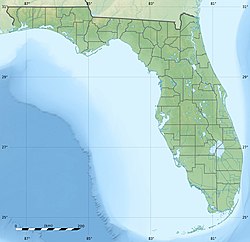
Back Tallahassee Afrikaans ታለሃሢ Amharic Tallahassee AN Talehæfesē ANG تالاهاسي Arabic تالاهاسى ARZ Tallahassee AST تالاهاسی AZB Talahasis BAT-SMG Талахасі Byelorussian
Tallahassee | |
|---|---|
| City of Tallahassee | |
| Motto: "Florida's Capital City" | |
 Location within Leon County and the state of Florida | |
| Coordinates: 30°27′18″N 84°15′12″W / 30.45500°N 84.25333°W | |
| Country | |
| State | |
| County | Leon |
| Established | 1824 |
| Government | |
| • Type | Council–Manager |
| Area | |
| • Total | 104.74 sq mi (271.27 km2) |
| • Land | 101.85 sq mi (263.80 km2) |
| • Water | 2.89 sq mi (7.47 km2) |
| Elevation | 203 ft (62 m) |
| Population | |
| • Total | 196,169 |
| • Rank | 127th, U.S. |
| • Density | 1,926.00/sq mi (743.64/km2) |
| • Urban | 252,934 (US: 162nd)[3] |
| • Urban density | 2,016.1/sq mi (778.4/km2) |
| • Metro | 385,145 (US: 140th) |
| Time zone | UTC−5 (Eastern (EST)) |
| • Summer (DST) | UTC−4 (EDT) |
| ZIP code(s) | 32300–32399 |
| Area code | 850 |
| FIPS code | 12-70600[5] |
| GNIS feature ID | 308416[2] |
| Website | www |
Tallahassee is the capital city of the U.S. state of Florida. As of 2020 Tallahassee has a population of 196,169 people.[4]
The name comes from the Apalachee Native American words: talwa meaning town, and ahassee meaning old.
Tallahassee was created as the capital of Florida during the territory's second legislative session. It was chosen as the midpoint between St. Augustine and Pensacola, which had been the capitals of the Spanish and British colonies of East Florida and West Florida, respectively. (At that time, very few people lived in the swamps of South Florida.) The first session of Florida's Legislative Council–as a territory of the United States–met on July 22, 1822 at Pensacola and members from St. Augustine traveled fifty-nine days by water to attend. The second session was in St. Augustine and required western delegates to travel perilously around the peninsula on a twenty-eight day trek. During this session, it was decided that future meetings should be held at a half-way point to reduce the distance. Two appointed commissioners selected Tallahassee, at that point an abandoned Apalachee settlement, as a halfway point. In 1824, the third legislative session met there in a crude log capitol.[6] Also in 1824, Marquis de Lafayette, French hero of the American Revolution, returned for a grand tour of the United States. The US Congress voted to give him $200,000 (the same amount he had given the colonies in 1778), US citizenship, and the Lafayette Land Grant, 36 square miles (93 km2) of land that today includes large portions of Tallahassee. In 1845, a Greek revival masonry structure was erected as the Capitol building in time for statehood.
In 1977, a 23-story high-rise Capitol building designed by architect Edward Durell Stone was completed. It is now the third-tallest state capitol building in the United States.[Note 1] In 1978, the old capitol was scheduled for demolition, but the State Of Florida decided to keep the Old Capitol as a museum and point of interest.
The city is the location of two important universities, Florida State University and Florida A&M University.
- ↑ "2020 U.S. Gazetteer Files". United States Census Bureau. Retrieved December 2, 2021.
- ↑ 2.0 2.1 U.S. Geological Survey Geographic Names Information System: Tallahassee, Florida
- ↑ "List of 2020 Census Urban Areas". census.gov. United States Census Bureau. Retrieved January 7, 2023.
- ↑ 4.0 4.1 "QuickFacts: Tallahassee city, Florida". United States Census Bureau. Retrieved September 17, 2023.
- ↑ "U.S. Census website". United States Census Bureau. Retrieved January 31, 2008.
- ↑ Florida: A Short History, Michael V. Gannon, ISBN 0-8130-1167-1, Copyright @ 1993 by the Board of Regents of the State of Florida
<ref group=Note> tags on this page, but the references will not show without a {{reflist|group=Note}} template (see the help page).










